Wolf Richter wolfstreet.com, www.amazon.com/author/wolfrichter
August wholesale auction price index hits record after longest series of year-over-year price gains since 2001.
Used-vehicle prices at wholesale auctions around the US ticked up 1.1% in August compared to August last year, eking out a new record, according to the Used Vehicle Value Index by Manheim, the largest auto-auction house, running about 8 million vehicles through its auctions a year. The index is adjusted for mix, mileage, and seasonality, but not for hurricanes and the dynamics of the new-vehicle market.
In the fall of 2017 and 2018, used-vehicle wholesale prices went through extraordinary spikes, ascribed to the effects of hurricanes that were thought to have destroyed hundreds of thousands of vehicles, which pushed up prices. When those theories turned out to have been exaggerated, prices dropped sharply over the winter in both years:
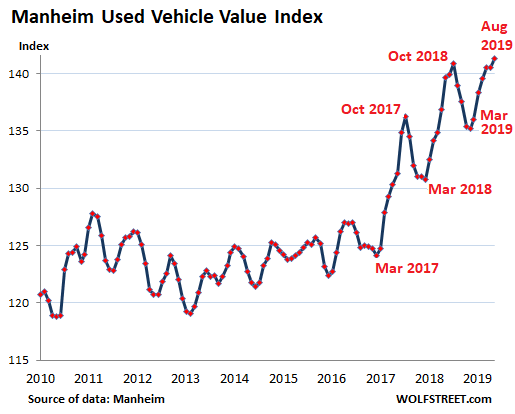
August was the 31st month in a row of year-over-year price gains, the longest such period of year-over-year price gains since April 2001. It beat the 29 months of year-over-year price gains from May 2009 through September 2011 — the period that followed the collapse of the auto industry during the Financial Crisis.
The 2009-2011 price gains were at first powered by the basic bounce-back from the 2008 collapse and then by the “Cash for Clunkers” program that started in July 2009. Cash for Clunkers was supposed to boost new-vehicle sales to help bail out automakers. Congress had appropriated $3 billion in two stages, that were gone in months.
Car buyers were handed this cash to trade in their “clunkers” and buy a new vehicle. The engines of the trade-ins under the program were destroyed and the vehicle went to the salvage yard for parts.
As an unintended consequence, the program destroyed a portion of the most affordable used vehicles – another blow to lower-income car buyers. By removing this supply of affordable cars from the market, Cash for Clunkers caused prices up the entire scale of used vehicles to surge.
This chart of year-over-year price changes of the Manheim Used Vehicle Value Index shows just how extraordinary the current 31-month series of price increases is, having now beaten the 29-month series following the Financial Crisis:
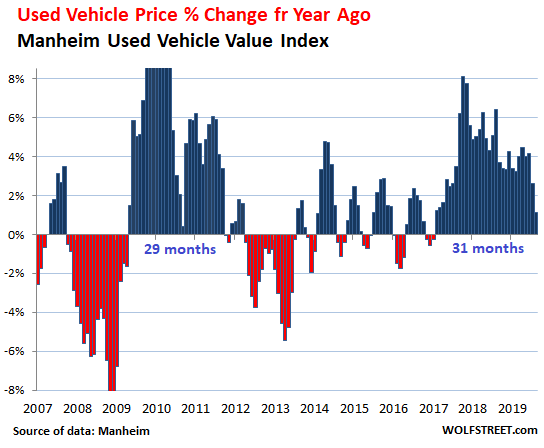
After the effects of the Financial Crisis and Cash-for-Clunkers had worn off, wholesale prices more or less stabilized from mid-2011 through May 2017, when they broke out again, with the index hitting a new record in August 2019:
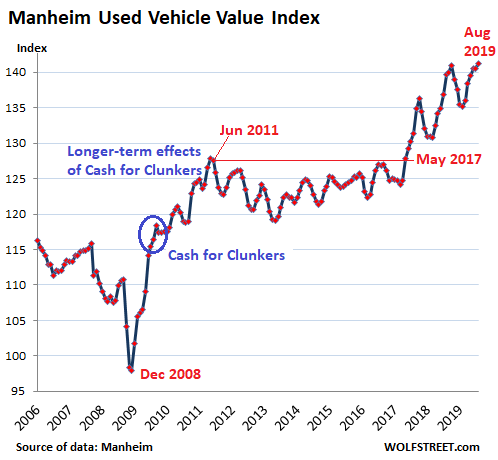
But the 1.1% gain in August was the smallest such gain in the 31-month series of gains, as wholesale prices appear to have bumped into resistance.
A big contributor to this slowdown in price gains was the near-flat average price (+0.2%) of midsize cars that earlier this year had seen blistering price gains in the 5% to 7% range.
Midsize cars and compact SUVs (SUVs based on a car platform) are the largest categories on the auction market, with compact SUVs having surpassed midsize cars for the first time in 2018, according to J.D. Power data. Based on current volume, each category will likely see over 700,000 vehicles being sold at auction in 2019.
But mid-size cars are dead on new-vehicle dealer lots. They’re at the core of what I call Carmageddon, the long-term collapse of “car” sales and the surge of “truck” sales. But “trucks” are SUVs, compact SUVs (which are essentially cars), pickups, and vans:
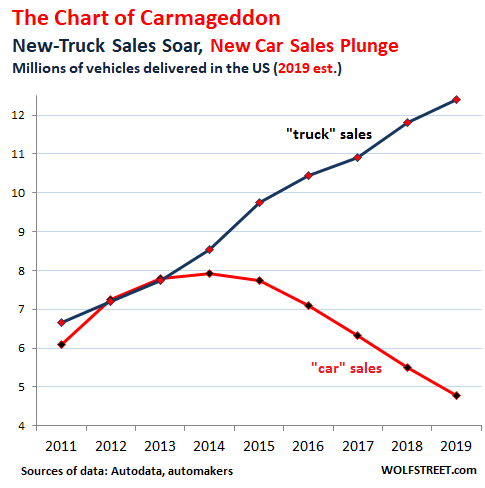
As new vehicles, midsize cars are too expensive for people looking for an affordable car and too small for the SUV- and truck-loving Americans that can afford to pay more. But rental car companies buy midsize in large numbers and about two years later, they dispose of them via auctions. Dealers buy them there, and put them on their lot as used vehicles, and that’s where Americans have been buying their affordable midsize cars.
Another factor in the slower year-over-year price gains in August was the performance of compact cars, the third largest category in the auction market. Like midsize cars, as a new vehicle, they’re at the core of Carmageddon. But rental fleets buy them in large numbers and two years later run them through the auctions, where dealers buy them to put them on their lots as affordable used cars.
Compact cars had had modest year-over-year price gains earlier in 2019, but in August, prices fell 2.7% from August last year:
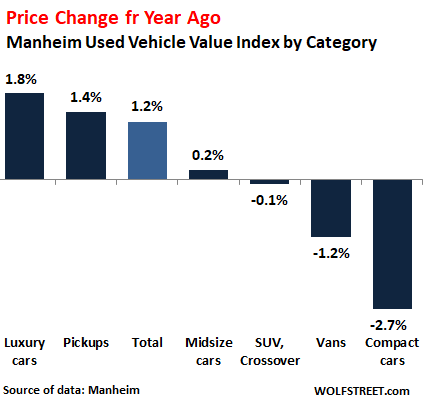
The used-vehicle market is far broader than the auction market, and includes retail sales at franchised and independent dealers, including retail-sales operations by rental fleets, along with person-to-person sales of used vehicles. The used-vehicle market’s estimated sales volume in 2019 of about 40 million vehicles far outpaces the estimated 17 million vehicle sales in the new-vehicle market.
For the overall used vehicle market, and not just auctions, prices rose 2.1% through July, compared to the same period last year, according to the successor of the NADA Used Car Guidelines, which had been acquired by J.D. Power in 2015, and is now called the J.D. Power Used Car and Light Truck Guidelines. The report attributes the price growth in the overall market this year to:
- New-vehicle prices that are now so high that they cause “affordability concerns”
- Large numbers of late-model off-lease vehicles coming into the used-vehicle market
- And “increased dealer demand for used vehicles,” based on increased retail demand for used vehicles because of the above “affordability concerns.”
In August, total used vehicle sales volume rose 1.8% year-over-year, according to estimates by Cox Automotive, which owns Manheim.
On the new-vehicle side, despite weakness in sales to retail customers, fleet sales have been strong so far in 2019, up 7.3%, according to Cox estimates. The large purchases by rental fleets will be a major source of supply for the used-vehicle market in the future, where more and more Americans are going to look for affordable vehicles after getting priced out of the new-vehicle market.
But these are the good times. And automakers are not amused. Read… Subprime Auto Loans Blow Up, Delinquencies at 2009 Level, Biggest 12-Month Surge Since 2010